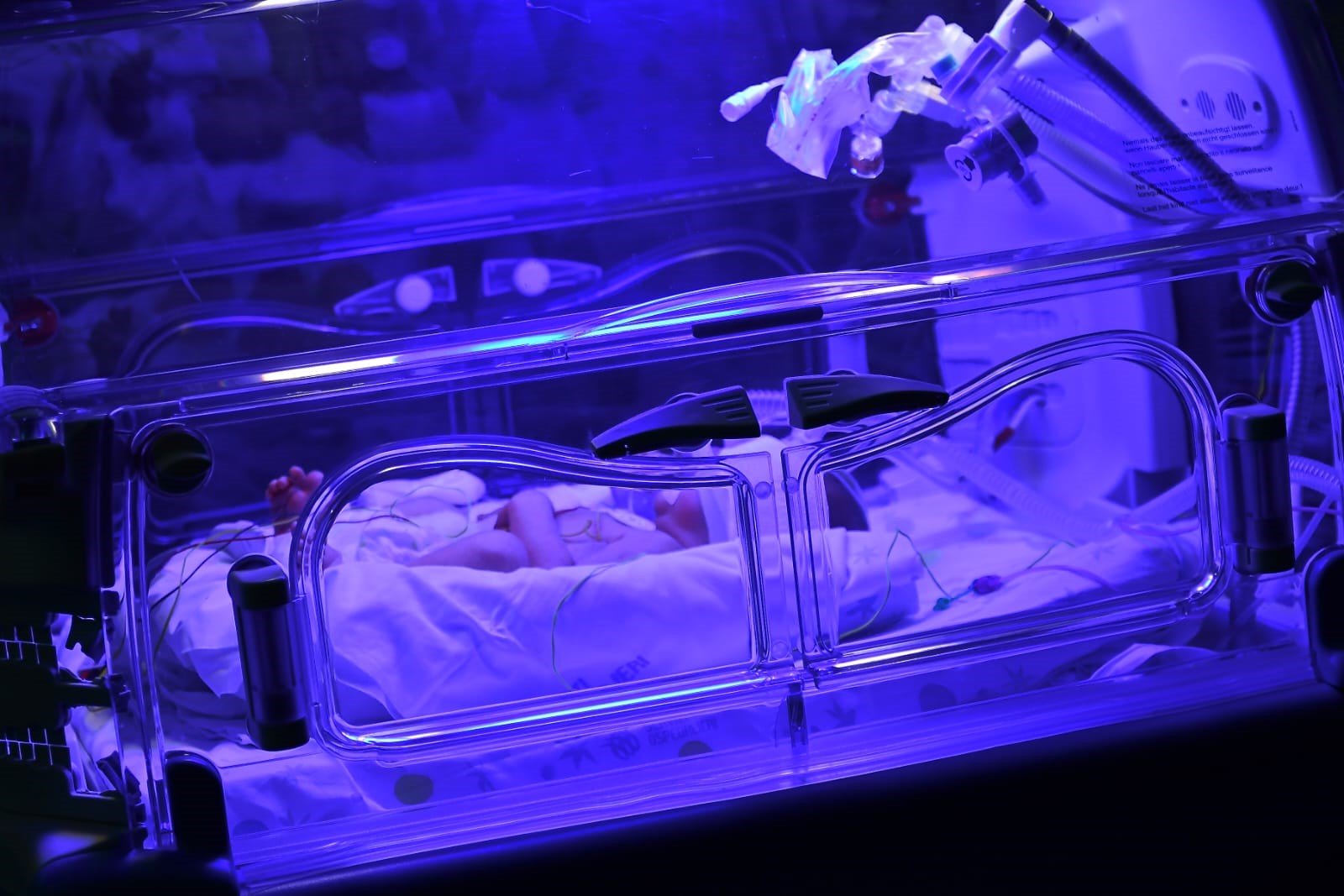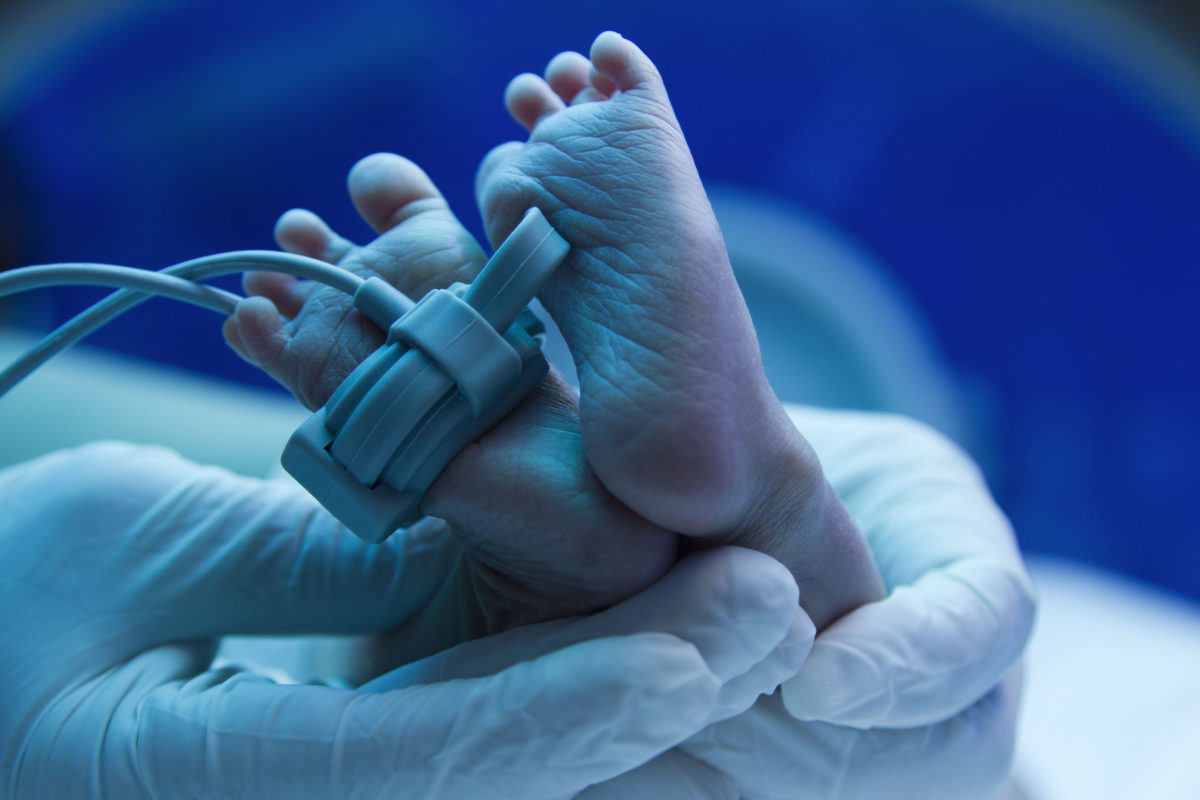
Bilirubin encephalopathy (kernicterus): neonatal jaundice with bilirubin infiltration of the brain
In medicine, bilirubin encephalopathy (also called ‘bilirubin encephalopathy’ or ‘kernitterus’ or ‘kernicterus’) refers to pathological neonatal jaundice with the passage (across the blood-brain barrier) and deposition of free bilirubin in the brain tissue of the newborn, especially in the basal ganglia and hippocampus
Bilirubin is a naturally occurring substance in the human body and in many other animals, but it is neurotoxic when its concentration in the blood is too high, a condition known as ‘hyperbilirubinemia’.
In addition to the typical yellowish discolouration of the skin and sclera of the eye, hyperbilirubinaemia can also cause accumulation of bilirubin in the grey matter of the central nervous system, which can lead to even severe neurological problems such as cerebral palsy, choreoathetosis and intellectual disability and other irreversible neurological damage.
Infants are particularly vulnerable to neurological damage induced by hyperbilirubinemia, because in the first few days of life, the still-developing liver is severely exerted by the breakdown of foetal haemoglobin as it is replaced with adult haemoglobin and the blood-brain barrier is not as developed.
Mildly elevated serum bilirubin levels are common in newborns and neonatal jaundice is not uncommon, but bilirubin levels must be closely monitored if they start to rise, in which case more aggressive therapy is required, usually by phototherapy but sometimes also by exchange transfusion.
Depending on the level of exposure, the effects range from clinically undetectable to severe brain damage and even death.
The doctors who mainly deal with kernicterus are paediatricians
The term ‘kernicterus’ was coined in 1904 by the German pathologist Christian Georg Schmorl (2 May 1861 – 14 August 1932).
Kernicterus, symptoms and signs
Symptoms and signs include severe jaundice (yellowish discolouration of the skin and sclera of the eye), hepatosplenomegaly and brain damage, such as choreoathetosis cerebral palsy, intellectual disability, lethargy, hypotonia (e.g. paresis of the eyes) and spasms.
Depending on the type, the symptoms may be different and more or less severe.
Classification
Bilirubin encephalopathy can be distinguished into three main types: acute, chronic, mild.
A) Acute bilirubin encephalopathy (ABE)
Acute bilirubin encephalopathy is an acute state of elevated bilirubin in the central nervous system: if hyperbilirubinemia is corrected at this stage of the disease, permanent neurological problems may be avoided. Clinically, it comprises a wide range of symptoms and signs. including:
- lethargy;
- decreased feeding;
- hypotonia or hypertonia;
- acute and inconsolable crying;
- spasmodic torticollis;
- absent or symmetrically reduced Moro reflex;
- opisthotonos (particular attitude of rigidity of the body in hyperextension due to prevalent contracture of the extensor skeletal muscles over the flexors);
- setting sun sign (paralysis of the upward and downward gaze, typical of Parinaud’s syndrome or dorsal midbrain syndrome or setting sun syndrome)
- fever;
- convulsions;
- coma and death (in severe cases).
If bilirubin is not rapidly reduced, acute bilirubin encephalopathy rapidly progresses to chronic bilirubin encephalopathy, which results in irreversible damage.
B) Chronic bilirubin encephalopathy (chronic bilirubin encephalopathy CBE)
Chronic bilirubin encephalopathy is a chronic state of severe neurological injury induced by chronic hyperbilirubinemia.
The reduction of bilirubin, if it occurs at this stage, does not however reverse the neurological sequelae, which then become irreversible.
Clinically, manifestations of chronic bilirubin encephalopathy include:
- movement disorders (dyskinesia, spasticity, severe motor disability in 60% of cases, with difficulty even in walking)
- auditory neuropathy (deafness);
- visual/oculomotor disabilities (nystagmus, strabismus, setting sun sign with altered upward or downward gaze and/or altered cortical vision). In rare cases, a decrease in visual acuity or complete blindness may occur;
- hypoplasia/dysplasia of the dental enamel of deciduous teeth;
- gastroesophageal reflux;
- reduced digestive function;
- impaired intellectual function: although the majority of individuals (approximately 85%) with kernitzer are within the normal or slightly lower than normal range of intelligence, in some, rarer cases, intellectual function is severely impaired;
- epilepsy (rare).
These impairments are associated with lesions in the basal ganglia, the auditory nuclei of the brainstem and the oculomotor nuclei of the brainstem.
Cortex and white matter are subtly involved.
The cerebellum may be involved. Severe cortical involvement is rare.
C) Mild bilirubin encephalopathy (subtle bilirubin encephalopathy, SBE)
Subtle bilirubin encephalopathy is a chronic state of mild neurological dysfunction induced by hyperbilirubin.
Clinically, this can cause neurological, learning and movement disorders, isolated hearing loss and auditory dysfunction.
CHILD HEALTH: LEARN MORE ABOUT MEDICHILD BY VISITING THE BOOTH AT EMERGENCY EXPO
Kernicterus and intellectual disability
In the past, kernitterus was often thought to cause severe intellectual disability.
This was assumed due to hearing difficulties, which are usually not detected in a normal audiogram accompanied by speech disorders, with choreoathetosis.
With advances in technology, this has proven not to be the case as those living with this disease have repeatedly demonstrated their intelligence using augmentative communication devices.
Although most people with kernicteric cerebral palsy have normal intelligence, some children with mild choreoathetosis develop mild intellectual disability even without auditory dysfunction.
About 85% of individuals with kernicterus are in the normal or slightly lower than normal intelligence range.
Only in rare cases, around 10% of cases, is the intellectual disability severe or very severe: this occurs mainly in cases of chronic hyperbilirubinaemia.
Causes of kernicterus
In the vast majority of cases, kernitting is associated with unconjugated hyperbilirubinaemia during the neonatal period.
The blood-brain barrier is not fully functional in neonates and therefore bilirubin is able to cross the central nervous system. In addition, newborns have much higher levels of bilirubin in the blood due to:
- rapid breakdown of fetal red blood cells immediately before birth, with subsequent replacement by normal adult human red blood cells. This rupture of the foetal red blood cells releases large amounts of bilirubin;
- presence of some kind of haemolytic Rh disease of the newborn, especially when the infant’s mother has an immune system lacking RhD (typical of Rh positive foetuses with Rh negative mothers). Possible contact between the mother’s blood and the baby’s blood, often present at the time of delivery, causes the mother to produce antibodies against the baby’s erythrocytes, antibodies that cross the placenta and haemolysise the newborn’s erythrocytes;
- administration of ceftriaxone, which binds to albumin, a protein whose functions include transporting bilirubin to the liver;
- infants have a limited ability to metabolise and excrete bilirubin. The only route for bilirubin elimination is through the enzyme uridine diphosphate glucuronosyltransferase isoform 1A1 (UGT1A1), which performs a reaction called ‘glucuronidation’. This reaction adds a large sugar to bilirubin, which makes the compound more soluble in water, so it can be excreted more easily through urine and/or faeces. The enzyme UGT1A1 is not active in appreciable quantities until several months after birth. Apparently, this is a developmental compromise as the maternal liver and placenta perform glucuronidation for the foetus;
- administration of aspirin to infants and children. Aspirin displaces bilirubin from serum albumin, thus generating an increased level of free bilirubin that can cross the developing blood-brain barrier.
Bilirubin is known to accumulate in the grey matter of neurological tissue where it exerts direct neurotoxic effects.
Its neurotoxicity appears to be due to the mass destruction of neurons by apoptosis and necrosis.
Risk factors for bilirubin encephalopathy are:
- premature birth;
- Rh incompatibility;
- polycythaemia;
- familiarity;
- sulphonamides (e.g. co-trimoxazole);
- Crigler-Najjar syndrome, type I;
- G6PD deficiency;
- Gilbert syndrome.
Diagnosis of kernicterus
The diagnosis is based on the medical history (e.g. premature birth or family history), objective examination (jaundice, absent or reduced Moro reflex, lethargy, setting sun sign, etc.) and laboratory tests (serum bilirubin values above 20 mg/dl).
At present, there is no effective treatment for kernicterus
Future therapies may include neuroregeneration.
Some patients have undergone deep brain stimulation and experienced some benefits.
Drugs such as baclofen, clonazepam, gabapentin and triesiphenidyl are often used to manage movement disorders associated with kernitters. Proton pump inhibitors are also used to help with reflux.
Cochlear implants and hearing aids are also known to improve the hearing loss that can result from kernitters (auditory neuropathy).
RARE DISEASES? VISIT THE UNIAMO – ITALIAN FEDERATION FOR RARE DISEASES BOOTH AT EMERGENCY EXPO
Complications and risks
Kernitzer often proves fatal for the sufferer, the course of which involves hypertonia, lethargy, apnoea, convulsions, while for those who survive, permanent damage is found in cerebral palsy, dental dysplasia, hearing and/or sight loss.
Prevention
Measuring serum bilirubin is useful for assessing a child’s risk of developing kernitimerosis: the data are plotted on the nomogram.
To prevent this disease, blue light phototherapy is used (ultraviolet light degrades bilirubin into water-soluble derivatives) and in severe cases exsanguinotransfusion.
Read Also:
Emergency Live Even More…Live: Download The New Free App Of Your Newspaper For IOS And Android
Shaken Baby Syndrome: The Very Serious Damage Of Violence On The Newborn Child
Rare Diseases: Bardet Biedl Syndrome
Rare Diseases: Positive Results Of A Phase 3 Study For The Treatment Of Idiopathic Hypersomnia
Rare Diseases: Fibrodysplasia Ossificans Progressiva (FOP), A Study From Pennsylvania University
Eczema Or Cold Dermatitis: Here’s What To Do
Pain Management In The Paediatric Patient: How To Approach The Injured Or Aching Children?
Pericarditis In Children: Peculiarities And Differences From That Of Adults
In-Hospital Cardiac Arrest: Mechanical Chest Compression Devices May Improve Patient Outcome
Stress And Distress During Pregnancy: How To Protect Both Mother And Child
Chronic Pain And Psychotherapy: The ACT Model Is Most Effective
Paediatrics, What Is PANDAS? Causes, Characteristics, Diagnosis And Treatment
Pain Perception In Children: Analgesic Therapy In Paediatrics
Obstructive Sleep Apnoea: What It Is And How To Treat It
Obstructive Sleep Apnoea: Symptoms And Treatment For Obstructive Sleep Apnoea
Psoriasis, An Ageless Skin Disease
Transient Neonatal Dermatosis? Don’t Worry, Here’s What They Are
Croup In Children: Meaning, Causes, Symptoms, Treatment, Mortality
Children At Risk Of Heat-Related Illnesses In Hot Weather: Here’s What To Do
Gastroschisis: Diagnosis And Treatment Of This Rare Neonatal Disease
West Syndrome: Symptoms, Diagnosis And Treatment Of This Rare Disease



